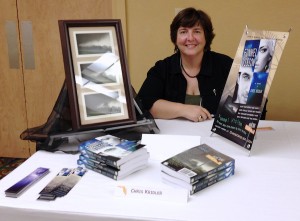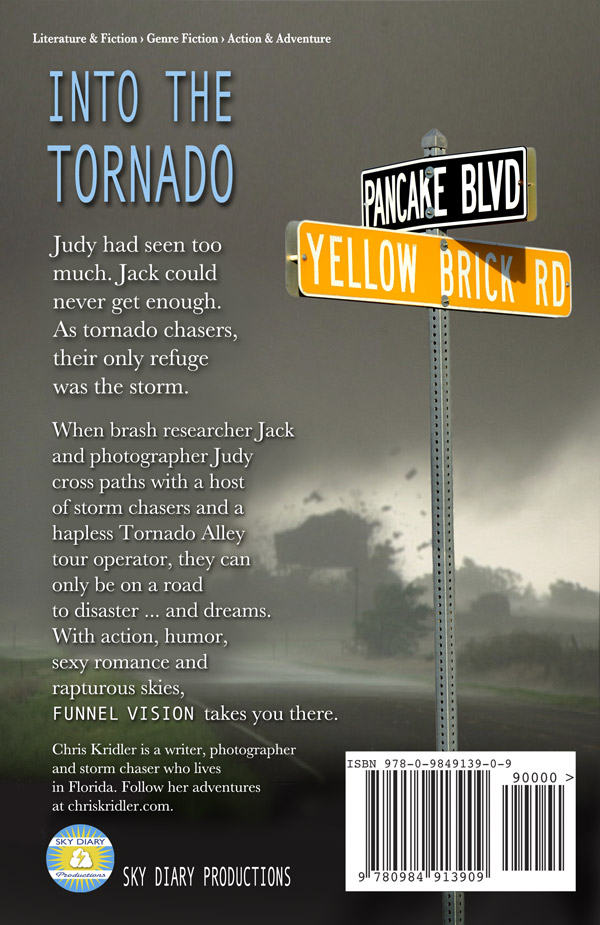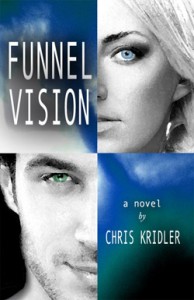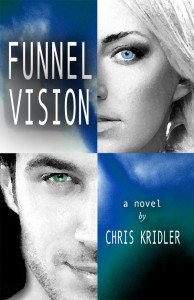On Friday, make sure you check out my friend Kam Miller’s blog, Glass Half-Full in Hollywood. Kam is an experienced TV and film writer and offers fabulous advice straight from Hollywood’s movers and shakers. And speaking of shakers, she also features Friday cocktails on the blog. I’m guest-blogging there Friday about Tales of the Cocktail, the convention in New Orleans from which I just returned (and from which I’m still recovering). While I was there, I helped The Times-Picayune cover the event with blogs, photos and videos.
I was wavering between amusement and horror today as I watched two friends take on the publishing revolution in a battle of 140-character grenades on Twitter. They made good points: Digital’s rise is formidable. Self-publishing pundits are “post-apocalyptic” about traditional publishing. And so on. But I started to worry about the vitriol I see in the wider debate about traditional vs. self-publishing. Why must it be one or the other?
There are people out there who love books but seem to hate, well, everybody on the other side. As if there were another side. As writers (and as publishers, self- or otherwise), I think we’re on the side of telling great stories. Or at least some of us are; even in my most Pollyanna moments, I have to admit that some people just want to make a buck, or many millions of bucks, as rare as that kind of success may be. Vintage Books didn’t pick up the “Fifty Shades” trilogy because of its literary value. Some maudlin bestsellers seem more cynical than sincere. And publishing, big or small, is a business, and writers will make decisions accordingly.
Still, even though making money from writing is a kind of validation, or ideally, a living, it’s not the main reason most writers write.
Perhaps it’s not true of you, Writer, but I think most writers, whether they aim to create great art or craft the perfect thriller, ultimately want to be read. To be read, one must be published, one way or the other. How we publish books is important to their success, but I don’t think one’s strategy has to be all or nothing, Us vs. Them. But that’s the way the discussion unfolds. Wordsmiths turn into cornered animals. Given the upheaval in publishing, it’s no wonder the traditionals feel threatened and the upstarts feel defensive. Livelihoods and reputations are at stake. I’ve seen self-publishing advocates eviscerate traditional publishers for being short-sighted and rapacious (see Jessica Clark’s screed, which is compelling partly because she came from traditional publishing). I’ve seen traditionally published authors snark about the unwashed self-published, whose books, by definition, must suck.I hate to be sensitive to the latter stance, but I am, a little. Though I once had similar opinions, I chose to self-publish earlier this year after going through several rounds of traditional-pub rejection and years of angsting and revisions. I did it not because I think it is the one shining path to revolution, but because it just made sense for me. My novel apparently defied genre, I wasn’t getting any younger, I was actually happy with it, and self-publishing was exploding. It was a business and personal decision. I made back my expenses, and I’m glad it’s out there.
But never mind my book. I know writers who are still struggling to get published the traditional way, writers I’ve worked with closely over glasses of wine, and their stuff is brilliant. But agents/publishers haven’t wanted these brilliant books for whatever reason, and I fear they will never be read beyond a few lucky critique partners. That’s enough reason to self-publish a book.
Sure, a lot of self-published books still stuck – as do some traditionally published books. I always think of Flannery O’Connor’s response to the question of whether universities discourage young writers: “My opinion is that they don’t stifle enough of them. There’s many a best seller that could have been prevented by a good teacher.” (1)
In the case of self-publishing, stifling is elusive. The vetting process is what’s missing, for good or ill, when you take away the traditional publishing grinder. We all need friction to smooth the rough edges. We need smart people to critique and edit our books before they see daylight. As a journalist and frequent book reviewer, I used to see many, many self-published books cross my desk. Long memories of poor design, bad grammar and amateur efforts mean the stigma will linger. But we’re seeing many more of these books published at a professional level, shaped if not screened by editors, and designed well. New and refreshing voices are emerging. Even if they are not bestsellers, they can find their niche. They can find their fans. They deserve to be heard, and not to be disdained without cause. And self-publishing also offers an option for traditionally published authors who want to stretch beyond what they’re told will sell, or who want to promote their work in a new way. (It’s Us and Them.)
Once published, all books should be held to the same standard (or the standard that fits – whether it does what it aims to achieve). I’m agog to hear critics and book bloggers say some self-pubbed authors have scared them off because said authors freak out if a review isn’t favorable or ask them to be “nicer” because the book is self-published. These unprofessional writers taint the rest, and more education is in order.
Even if all books are held to the same standard, traditionally published books still have the advantage of reach and marketing (or at least a publisher’s A-list books do). The big houses have already earned the respect of traditional media, who remain wary of embracing self-published books. As a recent graduate of newspapers, I can say that attitude is slowly changing, even as coverage of books is shrinking. But in the realm of media attention, the traditionals are likely to have the advantage for a long time. I definitely read more traditionally published books than self-published ones, because their media advantage makes them easier to discover.
Consequently, when it comes to marketing, self-publishers do sometimes smell a bit desperate. Blogs for “indie” writers tend to be much more about promotion and platforms and getting reviews, about Amazon and the effectiveness of giveaways (or should I say the glut of giveaways), than about writing. And that’s OK. I’ve learned a ton from these blogs. But the key is still writing a really good, professionally packaged book. That book will not exist in an indie vacuum. It is one of millions published each year around the world, and it has to earn a place in a much larger literary landscape.
We’ve entered an era when even an unconventional, unproven, transcendent writer can hope to see his book in print, no matter how small the publishing scale. The hope is that the good books will get respect. With time and luck, they should do so, no matter how they’re published.
Storm chasers get great footage, but some of the most dramatic and intense footage I’ve seen has been by people who shot tornadoes from their homes or backyards. It’s not just their proximity to the storm in question; the storms are coming to them, after all. It’s also the sense that their homes are in peril; that their nightmares are coming to life; that they’re envisioning the destruction and what will come after – or remembering a disaster that came before.
The character of Judy in my novel “Funnel Vision” has this feeling whenever she sees a tornado, and especially if a storm threatens her town in Kansas. It’s easy to put yourself in her shoes when you see videos like this one by Kevin Adkins from West Liberty, Kentucky, on March 2. I have dreams about wall clouds and tornadoes like this – massive and ominous, whose real-time rotation is so rapid it looks like a special effect. The fact that the tornado is grinding through the mountains makes this video even more surreal; like a horror-movie monster, its terrible form can’t be seen until it’s just about to consume you.
It’s been a month since my virtual book launch. I self-published Funnel Vision in hopes of not just sales – I don’t have dollar signs in my eyes, despite the success of a few self-published authors – but in the hopes of gaining readers for a novel that I have lived with for a long time.
Still, people are curious about sales, so I can say I’m now in the 20 percent club – books that have sold more than a hundred copies. I hit that mark a couple of weeks in. Sales did well in the first few weeks thanks to a lot of great support during the launch. They’ve slumped in the past week, but dips are to be expected, I think. I hope. And despite modest sales, it’s done pretty well in customer-review rankings. If you looked today in the two Amazon genres in which the Kindle edition is listed, it was No. 34 in top-rated romantic suspense and No. 139 in top-rated action-adventure (a HUGE category, so – hooray!). But I’m pretty sure these review rankings don’t really help get a book discovered by the masses. It takes being in the top 100 in sales on any given list. And that goal is many, many thousands of rungs above me on Amazon’s ladders.
Sales aside, it’s really interesting seeing the book reviews come in. I’ve been lucky in receiving some nice ones on Amazon, even from people I don’t know or don’t know well. But as it’s not about the sales, it’s also not necessarily about the stars (though you’ve gotta love ’em). I am fascinated by readers’ reaction to the story, which is still something I’m thinking about every day as I write a sequel. Could a reader really be friends with my heroine? Is the hero sexy or despicable? I love to read these thoughts, no matter how disparate, because it means people are reading the story and, gosh darn it, having a reaction. And isn’t that what we want as writers? On the other hand, I have to be careful not to let these lovely voices get inside my head as I continue writing in this fictional world. I have to let my characters find their own way.
If you want to weigh in and haven’t read this storm-chasing adventure, the e-book is on Kindle and Nook. It’s also available in paperback. Get more info and see the book trailer here. Happy chasing!
I had the pleasure of speaking with Court Lewis, host of American Variety Radio on select public-radio stations, about storm chasing and my novel “Funnel Vision” for a show that will air starting this week. Catch it at 8:30 p.m. this Thursday on WETS 89.5 FM (Tri-Cities, Tennessee); at 7:30 a.m. Sunday on WFIT 89.5 FM (Melbourne, Florida); at 4:30 p.m. Sunday on WMFE 90.7 FM (Orlando, Florida) and 9:30 a.m. Wednesday, Feb. 15, on WQCS 88.9 FM (Fort Pierce, Florida). Or you can always catch it in the archives online after it airs.
If you missed me on Nerdy@30 on Blog Talk Radio, listen here. That was a lot of fun, too. Host Marcus Kastler lives in Kansas, so he has firsthand knowledge of severe storms.
I had a great time today chatting with UCF students in online classes. Great questions. My madly typing fingers got a great workout. Does your group need a speaker, or would your book club like to discuss ‘Funnel Vision’? Let me know.
My brain was so full after last weekend’s Space Coast Writers’ Guild conference in Cocoa Beach that I think it took a whole week to digest the information I gathered there. The truth about a writers’ conference is that, even if you don’t get practical advice (though you pretty much always do), you’re going to get inspiration. You’re surrounded by ambitious writers, by smart authors and editors and literary agents, and no amount of mediocre hotel food can turn off your appetite for everyone’s enthusiasm. You go home wanting to plot, and write, and do all the things it takes to get your book out into the world. Make that books. Which leads us into five takeaways I got this time around:
1. Your writing career isn’t about getting one book published. It’s about writing and publishing multiple books. Agents and editors are looking for career writers, not one-tome wonders. Even if you’re doing the self-publishing thing, the one sure way to build fans is to write multiple books so they have somewhere to go when they’ve finished reading the first one. To write all those books, you need the discipline to write every day, even if you have another job. There are no shortcuts. And while one project is well under way, another (or two) should always be in the works. (Thanks, author Davis Bunn.)

Sure, I'm game: With my novel "Funnel Vision," I was among the writers signing books at the Jan. 28 event.
3. The dream of getting your book into the big bookstore above all else may be misplaced. While it’s lovely to get your book into the big bookstore, more book sales take place online now than in stores. And even though it’s important to know your genre so you can market your book and pick the appropriate categories for it, self-published or not, keywords and online marketing may be just as important as being on a particular shelf. (Thanks, Cadence Group‘s Bethany Brown.)
4. Don’t fear Twitter. It’s a great way to (a) raise awareness of your own books, but (b) even better, learn from other writers and publishing industry types. This is a message I conveyed in my session on how to present yourself professionally to the press, but it was echoed in many sessions during the weekend. Social-media immersion continues to be important, as long as you keep in mind it’s not all about self-promotion. The experts say 70 percent of what you post shouldn’t be tooting your own horn. Share knowledge, share links, and respond to other folks online. In other words, be the person you want to listen to. (Thanks, Jeremy Reis.)
5. This may be the age of DIY self-publishing, but the key to success at self-pubbing is to be just as professional as the pros. Have a professional cover, a professional interior design, and professionally edited text. Readers can smell an amateur project a mile off, and they won’t respect your book if it’s not done well. And as much as we writers would like to hide in our respective garrets/basements/ivory towers and write, and have someone else carry our book outside, package it and share it with the world, that’s our job, too, more than ever. We’re all doing our own marketing. Horrible word, right? So think of it as sharing. Make friends, be supportive of other writers, do your research, spread the word, and people – with luck – will discover your book. Because in the end, it’s not about the money and the fame, both of which are in short supply. At least for me, it’s about the love, it’s about telling the stories, and it’s about finding readers for my book – and writing the next one. See point No. 1.
I am so grateful to friends and supporters who downloaded or bought the paperback of my storm-chasing novel Funnel Vision during its launch Tuesday. While it didn’t stir up a tornado on Amazon’s charts, it did create a bit of a dust devil.
The novel briefly bumped up above 6,000 (rankings, NOT sales) on the paid Kindle chart. That’s from selling 40ish Kindle editionsFor more insight into rankings, check out Richard Mabry’s guest post on Rachelle Gardener’s blog. He cites Rampant TechPress’ guesstimation that books ranked 1-10,000 are calculated every hour; 10,000-110,000 every day; the rest, once a month.
For a little perspective, Amazon offers more than a million books and periodicals on Kindle, a spokeswoman told me today. More than 800,000 books cost less than $10, plus there are millions of free out-of-copyright works, she said.
The Kindle charts are divided into paid and free, and a lot of authors are taking advantage of “free” to boost their sales, their visibility, or their supposed readership. I say “supposed” because I know I’m not the only one who’s downloaded free books to my iPhone’s Kindle app or the iBooks app and never read them. Still, it’s hard to ignore the potential of ebooks, now that 29 percent of American adults own a computer tablet or e-reader, according to a Pew study. In December, Amazon says, customers bought more than a million Kindle devices a week. These figures answer with an emphatic “NO” the question some have posed about whether e-book sales have reached their peak.
Russ Grandinetti, VP of Kindle Content at Amazon, said today that Kindle book sales have outstripped print books, according to an item in eBookNewser. That’s from an online retailer, though; print books still account for 80 percent of the market, according to a USA Today story.
I found that my own paperback did better than I expected, and its “real book” ranking this morning was in the 17,000+ range. I think some people want to feel the book in their hands and get it signed, too.
Since there are so many charts on Amazon, and none cumulative (at least that I’ve seen) that combine your print and ebook sales, one could argue that rankings are kind of meaningless (but incredibly awesome if you make the top 100). Plus I’m selling on Nook (Barnes & Noble’s figures seem to be lagging reality) and eventually iBooks, if Smashwords delivers it. But if you look around at where you are as an author – pretty much wherever you are on a given day – you’re probably in pretty good company. And as someone who has just published a novel, I’m just thrilled to find readers. Get more information on Funnel Vision here.
WHERE TO BUY
On Amazon: Funnel Vision Kindle edition | Funnel Vision paperback
Also on B&N Nook | Smashwords | Coming soon to iBooks/iTunes
And in case you missed the book trailer:
So this is what it means to be your own publisher. Terror. Typos. Eye strain from way too much time looking at web sites. Yet another reason why it would be nice if someone else did all that work.
But this is the path I have belatedly chosen, self-publishing, and in the DIY culture of today’s media, it’s a real education. I actually kind of like the process. If you haven’t been through it, let me give you the rundown of what it’s taken so far to get Funnel Vision out into the world – and it’s not quite there yet.
1. Write the book. Rewrite the book. Edit the book. Share with critique partners. Rewrite again. (Insert years here spent trying to get an agent to like it enough to pick it up, as I did.) Get serious. Rewrite again. See the world changing fast. Decide to publish it yourself.
2. Buy ISBNs. This isn’t what everyone does, as a lot of publishing services provide them, but I felt that to be serious, I wanted the block of Bowker numbers for each edition.
3. Design book/hire someone to design book. Did I mention DIY? I’m a ridiculous do-it-yourselfer. (Sometimes that’s called a “control freak,” though I’m always happy to get professional assistance.) I wanted to see if I could come up with a cover that made me happy. I have some background in graphic design, thanks to a long career in journalism. With a couple of stock photos of good-looking people, carefully transformed, and my own tornado photography, I made my own cover with Photoshop. That includes a back cover with a tornado image I shot and an only mildly manipulated sign photo – that’s a real sign in Liberal, Kansas, and fits my story perfectly. I used Word to design the inside of the book.

Here's the BACK cover of 'Funnel Vision' - something you don't see when shopping for an e-book. Design by Chris Kridler, chriskridler.com
5. Create e-book editions. I am wonky enough to make my own web pages, so I thought this wouldn’t be hard, and it wasn’t – very. That said, it was a glitchy process, as I exported a slightly stripped-down Word file to a web-page file (HTML), then used the friendly, free program Calibre to convert to ePub (for Barnes & Noble Nook) and mobi (for Kindle
6. Plan launch. I am doing scattershot marketing. I’ve created an online press kit, sent out a press release to the local paper, created a book trailer (DIY again), and signed up for lists of media looking for interviewees. I have a lot more to do, but I have to keep in mind that during all of this empire-building, I really need to be writing my next book. I’ll be signing books at 1:15 p.m. Jan. 28 at the Space Coast Writers’ Guild conference at the International Palms Resort in Cocoa Beach with other writers of proven fabulousness. As they say, I’m just happy to be here.
7. Hurry up and wait. I’m planning a virtual book launch party for Tuesday – that’s Jan. 24. I hope my friends and anyone with an interest in Funnel Vision will log on that day and buy the Kindle e-book
8. Enter twilight state of amazement (pull down pants). OK, that’s just me. I have a bit of trepidation now that I’m pushing this book out in the world. I’ve lived with it for a long time. It’s intensely personal to me, despite all this talk of the superficialities of design and code and marketing. And I am really feeling one of my favorite literary quotes, from Edna St. Vincent Millay: “A person who publishes a book appears willfully in public with his pants down.” This seems even more true, having not been gilded by the official blessings of the great publishing machine. It’s out there. It’s naked. I hope it finds friends.
I won’t be strutting around saying I am a “published author.” But I can quietly say I’m a “self-published author.” These days, that’s not such a bad thing, right? On with Funnel Vision !
I was wondering if the giveaway of ‘Funnel Vision’ had gone live yet on Goodreads, and holy cow, has it ever! I’m grateful for the requests and look forward to sending the five books out when the giveaway period ends Jan. 30. The Goodreads gods determine the lucky winners in all giveaways.
Here’s more stormy fun. I’ve just uploaded to YouTube a video I did almost five years ago, featuring 10 years of storms packed into 10 minutes. There’s a smattering of hail, lightning, storm structure and tornadoes, including several time-lapse clips and music.




